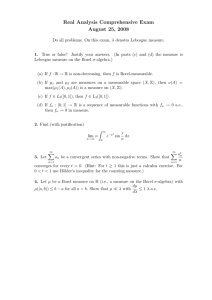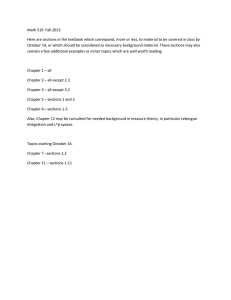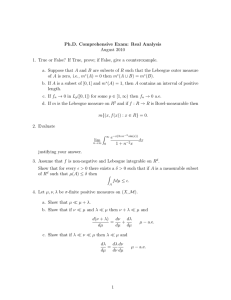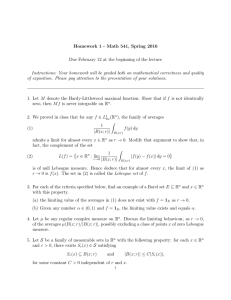Document 13377805
advertisement
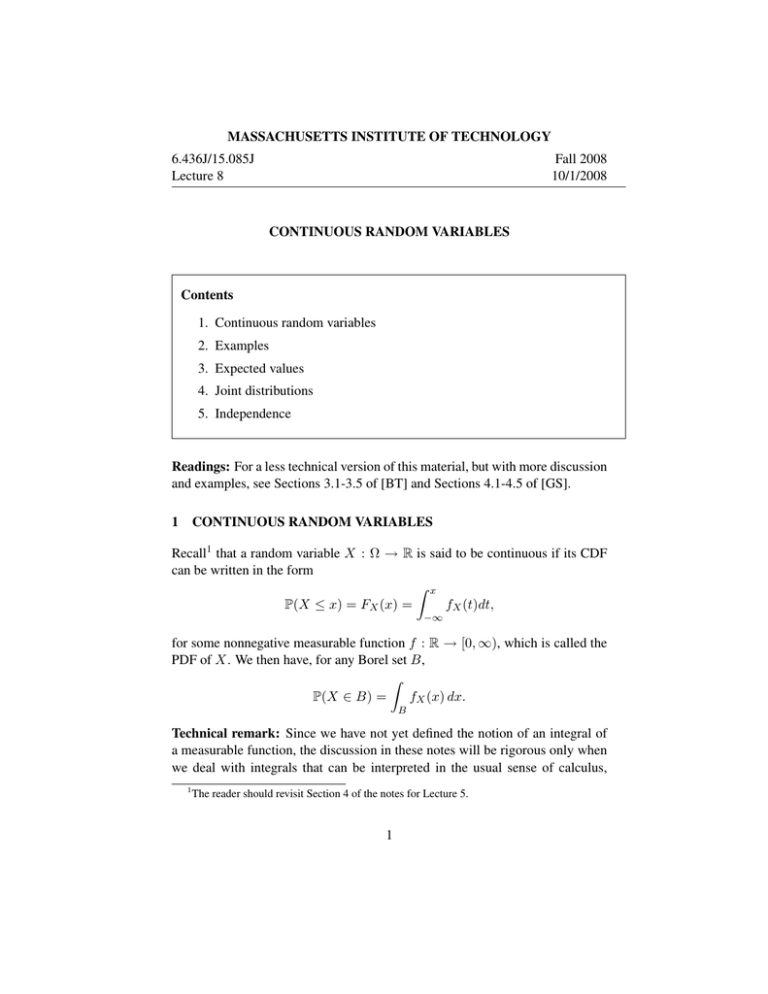
MASSACHUSETTS INSTITUTE OF TECHNOLOGY
6.436J/15.085J
Lecture 8
Fall 2008
10/1/2008
CONTINUOUS RANDOM VARIABLES
Contents
1. Continuous random variables
2. Examples
3. Expected values
4. Joint distributions
5. Independence
Readings: For a less technical version of this material, but with more discussion
and examples, see Sections 3.1-3.5 of [BT] and Sections 4.1-4.5 of [GS].
1 CONTINUOUS RANDOM VARIABLES
Recall1 that a random variable X : Ω → R is said to be continuous if its CDF
can be written in the form
� x
P(X ≤ x) = FX (x) =
fX (t)dt,
−∞
for some nonnegative measurable function f : R → [0, ∞), which is called the
PDF of X. We then have, for any Borel set B,
�
P(X ∈ B) =
fX (x) dx.
B
Technical remark: Since we have not yet defined the notion of an integral of
a measurable function, the discussion in these notes will be rigorous only when
we deal with integrals that can be interpreted in the usual sense of calculus,
1
The reader should revisit Section 4 of the notes for Lecture 5.
1
namely, Riemann integrals. For now, let us just concentrate on functions that are
piecewise continuous, with a finite number of discontinuities.
We note that fX should be more appropriately called “a” (as opposed to
“the”) PDF of X, because it is not unique. For example, if we modify fX at a
finite number of points, its integral is unaffected, so multiple densities can corre­
spond to the same CDF. It turns out, however, that any two densities associated
with the same CDF are equal except on a set of Lebesgue measure zero.
A PDF is in some ways similar to a PMF, except that the value fX (x) cannot
be interpreted as a probability. In particular, the value of fX (x) is allowed to
be greater than one for some x. Instead, the proper intuitive interpretation is the
fact that if fX is continuous over a small interval [x, x + δ], then
P(x ≤ X ≤ x + δ) ≈ fX (x)δ.
Remark: The fact that a random variable X is continuous has no bearing on the
continuity of X as a function from Ω into R. In fact, we have not even defined
what it means for a function on Ω to be continuous. But even in the special case
where Ω = R, we can have a discontinuous function X : R → R which is a
continuous random variable. Here is an example. Let the underlying probability
measure on Ω be the Lebesgue measure on the unit interval. Let
�
ω,
0 ≤ ω ≤ 1/2,
X(ω) =
1 + ω, 1/2 < ω ≤ 1.
The function X is discontinuous. The random variable X takes values in the set
[0, 1/2] ∪ (3/2, 2]. Furthermore, it is not hard to check that X is a continuous
random variable with PDF given by
�
1, x ∈ [0, 1/2] ∪ (3/2, 2]
fX (x) =
0 otherwise.
2 EXAMPLES
We present here a number of important examples of continuous random vari­
ables.
2
2.1 Uniform
This is perhaps the simplest continuous random
[a, b], and let
⎧
⎨ 0,
(x − a)/(b − a),
FX (x) =
⎩
1,
variable. Consider an interval
x ≤ a,
a < x ≤ b,
x > b.
It is easy to check that FX satisfies the required properties of CDFs. We de­
note this distribution by U (a, b). We find that a corresponding PDF is given
1
by fX (x) = (dFX /dx)(x) = b−a
for x ∈ [a, b], and fX (x) = 0, otherwise.
When [a, b] = [0, 1], the probability law of a uniform random variable is just the
Lebesgue measure on [0, 1].
2.2 Exponential
Fix some λ > 0. Let FX (x) = 1 − e−λx , for x ≥ 0, and FX (x) = 0, for
x < 0. It is easy to check that FX satisfies the required properties of CDFs.
A corresponding PDF is fX (x) = λe−λx , for x ≥ 0, and fX (x) = 0, for
x < 0. We denote this distribution by Exp(λ). The exponential distribution
can be viewed as a “limit” of a geometric distribution. Indeed, if we fix some δ
and consider the values of FX (kδ), for k = 1, 2, . . ., these values agree with the
values of a geometric CDF. Intuitively, the exponential distribution corresponds
to a limit of a situation where every δ time units, we toss a coin whose success
probability is λδ, and let X be the time elapsed until the first success.
The distribution Exp(λ) has the following very important memorylessness
property.
Theorem 1. Let X be an exponentially distributed random variable. Then,
for every x, t ≥ 0, we have P(X > x + t | X > x) = P(X > t).
Proof: Let X be exponential with parameter λ. We have
P(X > x + t | X > x) =
=
P(X > x + t, X > x)
P(X > x + t)
=
P(X > x)
P(X > x)
e−λ(x+t)
= e−λt = P(X > t).
e−λx
Exponential random variables are often used to model memoryless arrival
processes, in which the elapsed waiting time does not affect our probabilistic
3
model of the remaining time until an arrival. For example, suppose that the
time until the next bus arrival is an exponential random variable with parameter
λ = 1/5 (in minutes). Thus, there is probability e−1 that you will have to wait
for at least 5 minutes. Suppose that you have already waited for 10 minutes. The
probability that you will have to wait for at least another five minutes is still the
same, e−1 .
2.3 Normal distribution
Perhaps the most widely used distribution is the normal (or Gaussian) distribu­
tion. It involves parameters µ ∈ R and σ > 0, and the density
(x−µ)2
1
fX (x) = √ e− 2σ2 .
σ 2π
It can be checked that this is a legitimate PDF, i.e., that it integrates to one. Note
also that this PDF is symmetric around x = µ. We use the notation N (µ, σ 2 ) to
denote the normal distribution with parameters µ, σ. The distribution N (0, 1) is
referred to as the standard normal distribution; a corresponding random vari­
able is also said to be standard normal.
There is no closed form formula for the corresponding CDF, but numerical
tables are available. These tables can also be used to find probabilities associated
with general normal variables. This is because of the fact (to be verified later)
that if X ∼ N (µ, σ 2 ), then (X − µ)/σ ∼ N (0, 1). Thus,
P(X ≤ c) = P
�X − µ
c − µ�
≤
= Φ((c − µ)/σ),
σ
σ
where Φ is the CDF of the standard normal, available from the normal tables.
2.4 Cauchy distribution
2
Here,
� ∞ fX (x) = 1/(π(1 + x )), x ∈ R. It is an exercise in calculus to show that
−∞ f (t)dt = 1, so that fX is indeed a PDF. The corresponding distribution is
called a Cauchy distribution.
2.5 Power law
We have already defined discrete power law distributions. We present here a
continuous analog. Our starting point is to introduce tail probabilities that decay
according to power law: P(X > x) = β/xα , for x ≥ c > 0, for some parame­
ters α, c > 0. In this case, the CDF is given by FX (x) = 1 − β/xα , x ≥ c, and
4
FX (x) = 0, otherwise. In order for X to be a continuous random variable, FX
cannot have a jump at x = c, and we therefore need β = cα . The corresponding
density is of the form
fX (t) =
3
dFX
αcα
(t) = α+1 .
dx
t
EXPECTED VALUES
Similar to the discrete case, given a continuous random variable X with PDF
fX , we define
� ∞
E[X] =
xfX (x) dx.
−∞
�∞
This integral is well defined and finite if −∞ |x|fX (x) dx < ∞, in which case
we say that the random variable X is integrable. The integral
� 0 is also well de­
fined, but infinite, if one, but not both, of the integrals −∞ xfX (x) dx and
�∞
0 xfX (x) dx is infinite. If both of these integrals are infinite, the expected
value is not defined.
Practically all of the results developed for discrete random variables carry
over to the continuous case. Many of them, e.g., E[X + Y ] = E[X] + E[Y ],
have the exact same form. We list below two results in which sums need to be
replaced by integrals.
Proposition 1. Let X be a nonnegative random variable, i.e., P(X < 0) = 0.
Then
� ∞
E[X] =
(1 − FX (t)) dt.
0
Proof: We have
� ∞
� ∞
� ∞� ∞
(1 − FX (t)) dt =
P(X > t) dt =
fX (x) dx dt
0
0
0
t
� ∞
� x
� ∞
=
fX (x)
dt dx =
xfX (x) dx = E[X].
0
0
0
(The interchange of the order of integration turns out to be justified becuase the
integrand is nonnegative.)
5
Proposition 2. Let X be a continuous random variable with density fX , and
suppose that g : R → R is a (Borel) measurable function such that g(X) is
integrable. Then,
� ∞
E[g(X)] =
g(t)fX (t) dt.
−∞
Proof: Let us express the function g as the difference of two nonnegative func­
tions,
g(x) = g + (x) − g − (x),
where g + (x) = max{g(x), 0}, and g − (x) = max{−g(x), 0}. In particular, for
any t ≥ 0, we have g(x) > t if and only if g + (x) > t.
We will use the result
� ∞
� ∞
�
�
�
�
�
�
E g(X) =
P g(X) > t dt −
P g(X) < −t dt
0
0
from Proposition 1. The first term in the right-hand side is equal to
� ∞�
� ∞�
�
fX (x) dx dt =
fX (x) dt dx =
0
{x|g(x)>t}
−∞
{t|0≤t<g(x)}
∞
g + (x)fX (x) dx.
−∞
By a symmetrical argument, the second term in the right-hand side is given by
� ∞
� ∞
�
�
P g(X) < −t dt =
g − (x)fX (x) dx.
−∞
0
Combining the above equalities, we obtain
� ∞
� ∞
�
�
�
+
−
E g(X) =
g (x)fX (x) dx −
g (x)fX (x) dx =
−∞
−∞
∞
g(x)fX (x) dx.
−∞
Note that for this result to hold, the random variable g(X) need not be con­
tinuous. The proof is similar to the one for Proposition 1, and involves an in­
terchange of the order of integration; see [GS] for a proof for the special case
where g ≥ 0.
4
JOINT DISTRIBUTIONS
Given a pair of random variables X and Y , defined on the same probability
space, we say that they are jointly continuous if there exists a measurable2
2
Measurability here means that for every Borel subset of R, the set f −1 (B) is a Borel subset
of R2 . The Borel σ-field in R2 is the one generated by sets of the form [a, b] × [c, d].
6
fX,Y : R2 → [0, ∞) such that their joint CDF satisfies
� x � y
FX,Y (x, y) = P(X ≤ x, Y ≤ y) =
fX,Y (u, v) du dv.
−∞
−∞
The function fX,Y is called the joint CDF of X and Y .
At those points where the joint PDF is continuous, we have
∂2F
(x, y) = fX,Y (x, y).
∂x∂y
Similar to what was mentioned for the case of a single random variable, for
any Borel subset B of R2 , we have
�
�
�
�
P (X, Y ) ∈ B =
fX,Y (x, y) dx dy =
IB (x, y)fX,Y (x, y) dx dy.
R2
B
Furthermore, if B has Lebesgue measure zero, then P(B) = 0.3
We observe that
� x � ∞
P(X ≤ x) =
fX,Y (u, v) du dv.
−∞
−∞
Thus, X itself is a continuous random variable, with marginal PDF
� ∞
fX (x) =
fX,Y (x, y) dy.
−∞
We have just argued that if X and Y are jointly continuous, then X (and,
similarly, Y ) is a continuous random variables. The converse is not true. For a
trivial counterexample, let X be a continuous random variable, and let and Y =
X. Then the set {(x, y) ∈ R2 | x = y} has zero area (zero Lebesgue measure),
but unit probability, which is impossible for jointly continuous random variables.
In particular, the corresponding probability law on R2 is neither discrete nor
continuous, hence qualifies as “singular.”
Proposition 2 has a natural extension to the case of multiple random vari­
ables.
The Lebesgue measure on R2 is the unique measure µ defined on the Borel subsets of R2
that satisfies µ([a, b] × [c, d]) = (b − a)(d − c), i.e., agrees with the elementary notion of “area”
on rectangular sets. Existence and uniqueness of such a measure is obtained from the Extension
Theorem, in a manner similar to the one used in our construction of the Lebesgue measure on R.
3
7
Proposition 3. Let X and Y be jointly continuous with PDF fX,Y , and sup­
pose that g : R2 → R is a (Borel) measurable function such that g(X) is
integrable. Then,
� ∞� ∞
E[g(X, Y )] =
g(u, v)fX,Y (u, v) du dv.
−∞
−∞
5 INDEPENDENCE
Recall that two random variables, X and Y , are said to be independent if for any
two Borel subsets, B1 and B2 , of the real line, we have P(X ∈ B1 , Y ∈ B2 ) =
P(X ∈ B1 )P(Y ∈ B2 ).
Similar to the discrete case (cf. Proposition 1 and Theorem 1 in Section 3 of
Lecture 6), simpler criteria for independence are available.
Theorem 2. Let X and Y be jointly continuous random variables defined on
the same probability space. The following are equivalent.
(a) The random variables X and Y are independent.
(b) For any x, y ∈ R, the events {X ≤ x} and {Y ≤ y} are independent.
(c) For any x, y ∈ R, we have FX,Y (x, y) = FX (x)FY (y).
(d) If fX , fY , and fX,Y are corresponding marginal and joint densities, then
fX,Y (x, y) = fX (x)fY (y), for all (x, y) except possibly on a set that has
Lebesgue measure zero.
The proof parallels the proofs in Lecture 6, except for the last condition,
for which the argument is simple when the densities are continuous functions
(simply differentiate the CDF), but requires more care otherwise.
8
MIT OpenCourseWare
http://ocw.mit.edu
6.436J / 15.085J Fundamentals of Probability
Fall 2008
For information about citing these materials or our Terms of Use, visit: http://ocw.mit.edu/terms.
